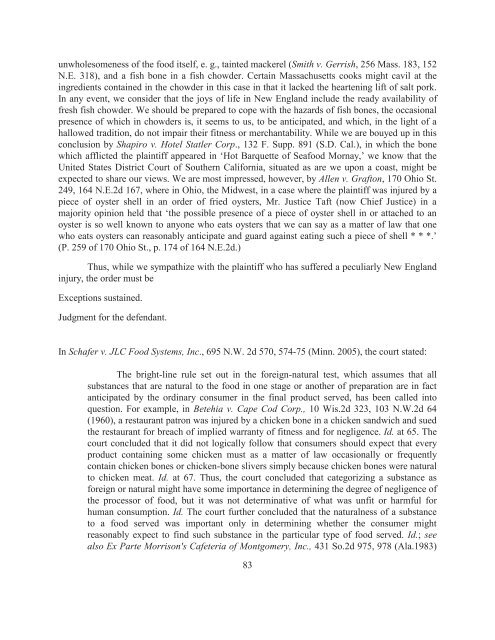Sales and Leases - A Problem-based Approach, 2016a
Sales and Leases - A Problem-based Approach, 2016a
Sales and Leases - A Problem-based Approach, 2016a
Create successful ePaper yourself
Turn your PDF publications into a flip-book with our unique Google optimized e-Paper software.
unwholesomeness of the food itself, e. g., tainted mackerel (Smith v. Gerrish, 256 Mass. 183, 152<br />
N.E. 318), <strong>and</strong> a fish bone in a fish chowder. Certain Massachusetts cooks might cavil at the<br />
ingredients contained in the chowder in this case in that it lacked the heartening lift of salt pork.<br />
In any event, we consider that the joys of life in New Engl<strong>and</strong> include the ready availability of<br />
fresh fish chowder. We should be prepared to cope with the hazards of fish bones, the occasional<br />
presence of which in chowders is, it seems to us, to be anticipated, <strong>and</strong> which, in the light of a<br />
hallowed tradition, do not impair their fitness or merchantability. While we are bouyed up in this<br />
conclusion by Shapiro v. Hotel Statler Corp., 132 F. Supp. 891 (S.D. Cal.), in which the bone<br />
which afflicted the plaintiff appeared in ‘Hot Barquette of Seafood Mornay,’ we know that the<br />
United States District Court of Southern California, situated as are we upon a coast, might be<br />
expected to share our views. We are most impressed, however, by Allen v. Grafton, 170 Ohio St.<br />
249, 164 N.E.2d 167, where in Ohio, the Midwest, in a case where the plaintiff was injured by a<br />
piece of oyster shell in an order of fried oysters, Mr. Justice Taft (now Chief Justice) in a<br />
majority opinion held that ‘the possible presence of a piece of oyster shell in or attached to an<br />
oyster is so well known to anyone who eats oysters that we can say as a matter of law that one<br />
who eats oysters can reasonably anticipate <strong>and</strong> guard against eating such a piece of shell * * *.’<br />
(P. 259 of 170 Ohio St., p. 174 of 164 N.E.2d.)<br />
Thus, while we sympathize with the plaintiff who has suffered a peculiarly New Engl<strong>and</strong><br />
injury, the order must be<br />
Exceptions sustained.<br />
Judgment for the defendant.<br />
In Schafer v. JLC Food Systems, Inc., 695 N.W. 2d 570, 574-75 (Minn. 2005), the court stated:<br />
The bright-line rule set out in the foreign-natural test, which assumes that all<br />
substances that are natural to the food in one stage or another of preparation are in fact<br />
anticipated by the ordinary consumer in the final product served, has been called into<br />
question. For example, in Betehia v. Cape Cod Corp., 10 Wis.2d 323, 103 N.W.2d 64<br />
(1960), a restaurant patron was injured by a chicken bone in a chicken s<strong>and</strong>wich <strong>and</strong> sued<br />
the restaurant for breach of implied warranty of fitness <strong>and</strong> for negligence. Id. at 65. The<br />
court concluded that it did not logically follow that consumers should expect that every<br />
product containing some chicken must as a matter of law occasionally or frequently<br />
contain chicken bones or chicken-bone slivers simply because chicken bones were natural<br />
to chicken meat. Id. at 67. Thus, the court concluded that categorizing a substance as<br />
foreign or natural might have some importance in determining the degree of negligence of<br />
the processor of food, but it was not determinative of what was unfit or harmful for<br />
human consumption. Id. The court further concluded that the naturalness of a substance<br />
to a food served was important only in determining whether the consumer might<br />
reasonably expect to find such substance in the particular type of food served. Id.; see<br />
also Ex Parte Morrison's Cafeteria of Montgomery, Inc., 431 So.2d 975, 978 (Ala.1983)<br />
83


















